In 1877, the Parliament of the young Kingdom of Italy established the start of an inquiry into the reality of the country’sagrarian economy sixteen years after Unification: the documents that the inquiry commission collected represent the most detailed snapshot of the sector in Italy in the 1880s. Reading those documents, drafted in the neutral and aseptic tones typical of official documents, it is possible to learn about the fate that was reserved for children who were born into peasant families: they were sent to kindergartens until “because of their tender age they are not fit for work,” and once they reached the age to work in the fields they followed their parents and began to devote themselves to the trades of the land. It was not uncommon for children as early as around the age of six to begin to help their father and mother in their activities: in the records of the aforementioned investigation, in the report on the province of Catania, we read that “the less affluent classes employ their children before the age of six to some household or field chores,” and this was also due to the fact that, in rural areas, school and education were not considered useful.
It was no better in the suburbs of large industrial cities, where children from the less affluent classes, especially those from families whose income was insufficient to cover the needs of all members, were immediately sent to work in factories. In 1844, the sixth meeting of Italian scientists was held in Milan from September 12 to 27: the conference, the most important of the time in Italy in the scientific sphere, met every year in a different city of the peninsula (still politically divided at the time) and was created to meet a specific need of the Italian scientific community of the time, that of measuring itself against the rapid and impressive progress that the world of science and technology had experienced in the first decades of the nineteenth century and, consequently, to discuss around the most pressing issues that progress necessarily entailed. Among the issues that emerged at the sixth meeting was that of child labor. In the proceedings, which contain a report on the work of children in Italian factories, we read a fundamental passage: “For 50 years already, as you know, in the nations where the unrestrained labor of modern industry, all ordered on individual competition, has been fermenting, the child began to be considered as a more economical means of production: machines did easily what previously had been done with such difficulty by the virile muscles; there was no need for work of patience and self-denial, or at most of dexterity. Women, the sprightly children found themselves better adapted to it than the limber workers. All too well known are the abuses that occurred there, painful to humanity, dangerous to the state, and to industry itself harmful. Children of 10, of 8, even of 5, shut up for 13 and sometimes 15 hours in mephitic workshops, bound to incessant labor, and when nature could no longer, with beatings obliged to move and watch; the two sexes without any supervision mixed together, exposed to long walks on public streets; fatiguing and interrupted sleep; sore, spoiled, weakened limbs; premature old age: and in the price of such labor, the brutishness and corruption that inspire disgust and disdain even to the pitiful.”
Thirty years later, the situation had not changed at all. In 1876, the then ministerial official (later a deputy and later also minister of finance) Vittorio Ellena (Saluzzo, 1844 - 1892) compiled an industrial statistic according to which, in the year 1870, as many as 90,083 children were employed in Italian factories in the textile sector alone, constituting more than 23 percent of the total workforce in the sector. Although children received one-third the wages of adults, they were still required to work grueling hours (well in excess of twelve hours a day), work night shifts, work in unhealthy working conditions, and remain illiterate (consider that, according to the official censuses of the kingdom, in 1881 males over the age of six who could neither read nor write accounted for 62 percent of the total). The performance of children, however, was considered important, not only by virtue of their lower cost than that of an adult (think of the fact that machines often did not require actions for which great strength was needed), but also because they were able to perform operations precluded to older children: in textile industries, for example, the smaller hands of very young female workers were better able to perform certain operations on yarn. As a result, the employment of minors in industries, factories and manufactures was definitely extensive.
Yet not many intellectuals were sensitive to the problem: in literature, for example, one can count the examples of Giovanni Verga and Luigi Pirandello, both Sicilians and therefore from an area where the exploitation of child labor was a very hard reality to eradicate. The point is that according to the mentality of the time, it was not strange for a child to work in the fields or in the workshops: thus, the theme of child labor was not one of the most relevant of the time, but there were nonetheless several artists who dealt with it, some animated by strong intentions of social denunciation, others simply moved by the desire to return a faithful narrative of the daily life of a community. No major exhibition has ever dealt with the subject of child labor in Italy between the 19th and 20th centuries, but the recent exhibition Colori e forme del lavoro at Palazzo Cucchiari in Carrara, while dealing with the theme of labor from a broader perspective and while it does not include sections devoted to the work of children and young people, nevertheless allows us to create a first path to explore some of the aspects of the issue.
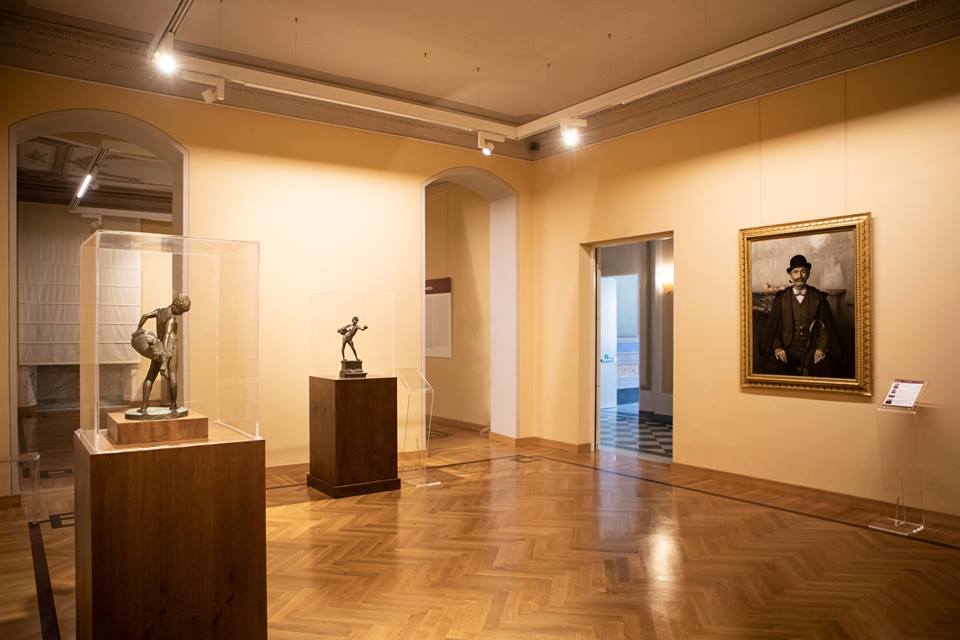 |
| A room of the exhibition Colors and Forms of Work in Carrara, Palazzo Cucchiari |
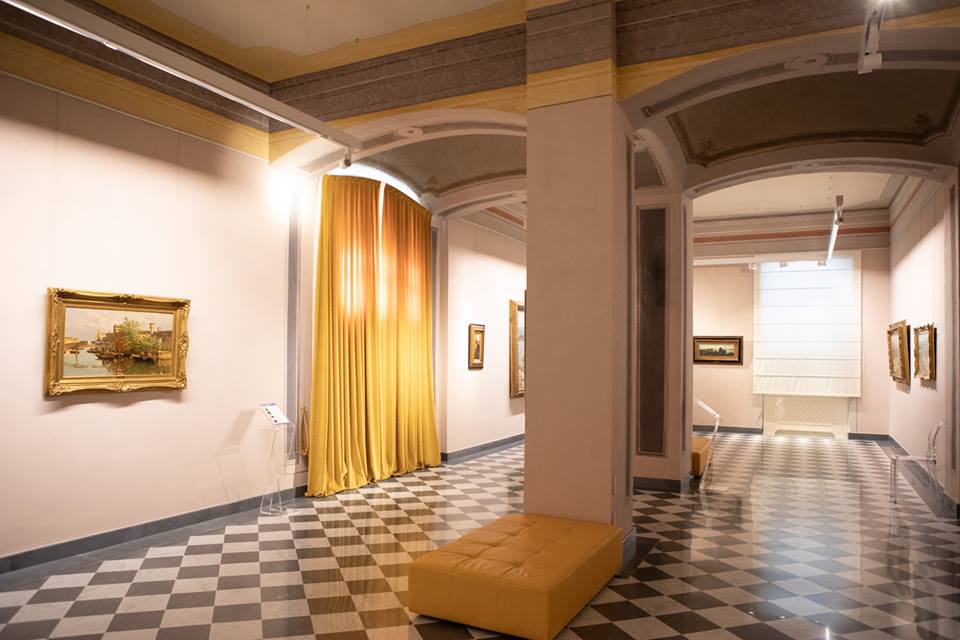 |
| A room from the exhibition Colors and For ms of Work in Carrara, Palazzo Cucchiari |
Within the Carrara exhibition, the work that perhaps more than any other exemplifies the conditions of children in the workplace is Nel casello, a work by Cirillo Manicardi (Reggio Emilia, 1856 - 1925). It is a scene that at the time could commonly be observed in the dairies of the Parma and Reggio plains (in the area the dairies are also known as “caselli”: hence the title of the painting): a child stands at the edge of a copper boiler and is mixing the milk with which parmesan cheese will be made (a job that today is done by machines). He is so short that he cannot reach the edge of the boiler and therefore needs to use, as a step, a wheel of Parmesan cheese. The painting, points out Ettore Spalletti, curator of the exhibition Colors and Forms of Work, “is resolved with loose and confident brushstrokes, which nevertheless still do not shy away from the search for sfumato and chiaroscuro, but nevertheless indicate the beginning of Manicardi’s gradual transition to narrative verism, with the specific intent of giving dignity and voice to aspects and moments of minute everyday life.” The fact that the child becomes the protagonist is symptomatic of the social instances that populate the art of Manicardi, one of the painters who, in the late nineteenth century, were most sensitive to the everyday reality of the humble. Instead, it takes on more narrative and idyllic tones in a work such as A far rena, a recently rediscovered masterpiece by Adolfo Tommasi (Livorno, 1851 Florence, 1933), which stands out for its strongly Impressionist accents. Masterful, in particular, is the Caillebotte-esque cut that brings the viewer to the boat of the two protagonists: two renaioli, or sand quarrymen, who are ploughing the Arno on their becolino (a special flat-bottomed boat ideal for sailing in shallow waters) to collect rena destined for construction. One of the two renaioli is a young boy, and Tommasi catches him in a moment of repose: that of renaiolo was a hard trade, typical of the inland areas of Tuscany near the Arno, to which all members of the family often devoted themselves, handing down the trade from generation to generation.
It could then happen (exactly as it happens nowadays) that, in the absence of work, mothers would take their children with them to beg: and it is precisely a beggar with her child who is the protagonist of the central panel(Poverty, from 1915) of the touching Trittico, an early masterpiece by Aldo Carpi (Milan, 1886 - 1973) that depicts a mother forced to beg in order to survive, in a desolate Po Valley countryside with dark and oppressive tones. In this painting, Spalletti points out, “social verism [...] seems to reconsolidate itself in a painting swollen with air and full of worries, even formally disrupted by dark forebodings, of war, hunger and death, as if to adapt the images to a world that promises to be black and white.” The problem of poverty that forced many families to live on handouts was also emphasized in the 1877 agrarian survey: “in particular, in the countryside of almost all of central Tyrrhenian Italy,” one reads, there abounded “masses of half-naked children who surround the visitor to ask him for alms,” and in the environs of Rome, “during the winter and spring seasons and particularly when field work is less fervent or suspended,” the city’s environs "are cluttered with the women and children who have emigrated to the countryside and are exercising begging in very considerable numbers.
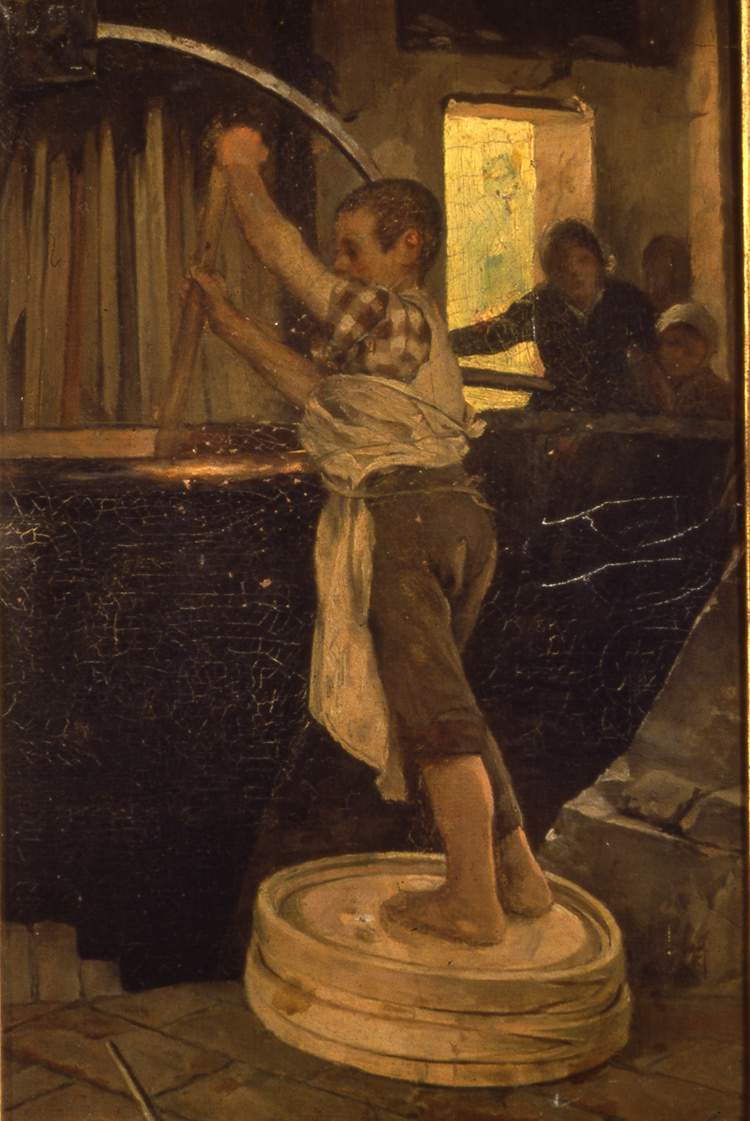 |
| Cirillo Manicardi, Nel casello (late 19th century; oil on canvas, 30 x 20 cm; Reggio Emilia, Musei Civici) |
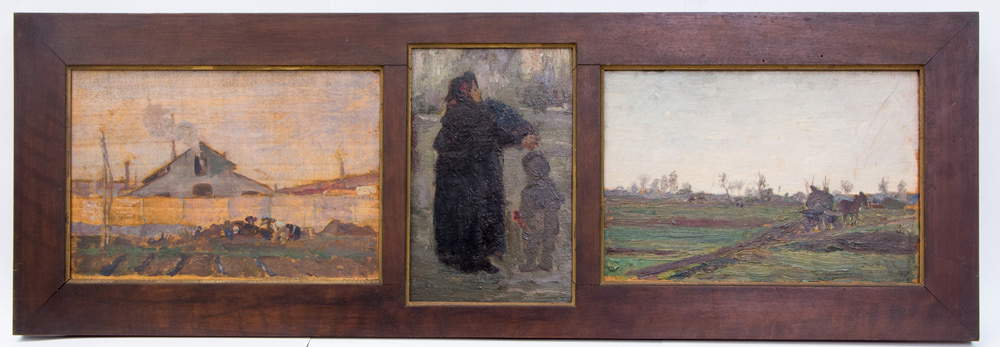 |
| Aldo Carpi, Triptych. Landscape with Factory (1913; oil on panel, 17 x 25.5 cm), Poverty (1915; oil on panel, 21 x 14 cm), Countryside (1919; oil on panel, 17 x 25.5 cm). Milan, Leonardo da VinciNational Museum of Science and Technology |
 |
| Adolfo Tommasi, A far rena (1882; oil on canvas, 92 x 55 cm; Livorno, Goldoni Art Gallery) |
Little workers were then also abundantly employed in retail trade, and they could not infrequently be seen in the markets, in the cities as well as in the countryside, selling produce, as evidenced by Giuseppe Moricci ’s Old Market (Florence, 1806 - 1879), a cross-section of a Florence that no longer exists where, among peddlers selling wagons and cheeses, carters transporting goods and women with shopping bags, two child vendors also roam about, in the foreground, offering their wares to passers-by. Obviously the children who were employed in the street trade sold small and easily transportable items: fruits, vegetables, newspapers, household items. The phenomenon was widespread, and the children were themselves market objects (they were literally sold, complete with contract, to business masters who sent them around the cities to sell or play), so much so that in 1868 the great writer Igino Ugo Tarchetti (San Salvatore Monferrato, 1839 - Milan, 1869), in an article published in the magazine Emporio pittoresco, launched an impassioned accusation: “In Italy there is a market for children; few know it, and will be amazed to learn it from our newspaper. This is how it begins and how it continues a traffic that is based on humanity in its most interesting form: childhood! In southern Italy, in a province that is richer than others, Basilicata, a large proportion of the inhabitants make a real industry of music and wandering.” The Parliament of Italy even had to pass a law in 1873 to curb the problem: under the title of “Prohibition of the employment of children of both sexes in wandering professions,” measures had been enacted to prevent the very young from engaging in a variety of activities (vendors, musicians, singers, acrobats, fortune tellers, questors).
However, as the chronicles of the time attest and as is also evident from the works of art, the law was not supposed to be very effective, if a few years later two great artists such as Vincenzo Gemito (Naples, 1852 - 1929) and Carlo Fontana (Carrara, 1865 - Sarzana, 1956) were able to try their hand by creating two bronze statues depicting as many water vendors, that is, young men who, on the streets of the cities, offered glasses of water to passers-by. In neither work (Gemito’s 1881, Fontana’s 1896) is there an intent to denounce: water vendors, especially in the south, were a habitual presence, which in the two sculptures by Gemito and Fontana is resolved in different ways. Gemito, Spalletti points out, “makes them an exquisitely popular figure [...] thus leading a figure of Neapolitan folklore back from fable to reality, from cultural suggestion to its popular roots” (in short: a kind of genre scene), and Fontana “in the classical flavor of the naked child vents a pause of wild idealism, and thus his aversion to academia, condensing love of matter and instinctive use of natural light, to give form and figure to elegiac impulses, instead of sentimental torments: a sculpture with a vague Impressionist flavor, but whose verist accents continue to oscillate between the classical serenity of the scene and the dynamic limpness of the figure.”
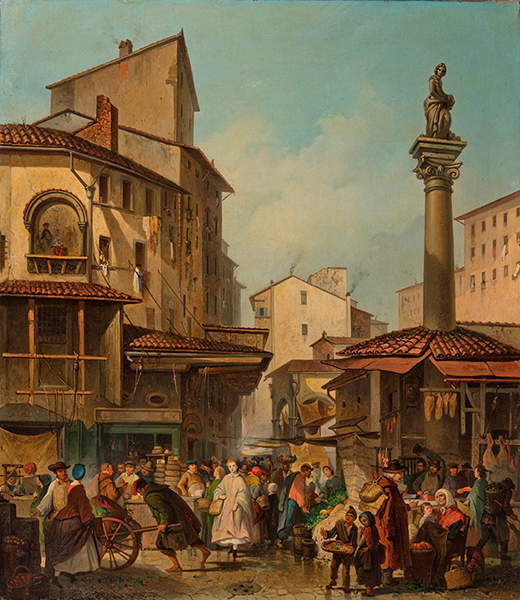 |
| Giuseppe Moricci, The Old Market in Florence (1860; oil on canvas, 84 x 74 cm; Florence, Uffizi Galleries) |
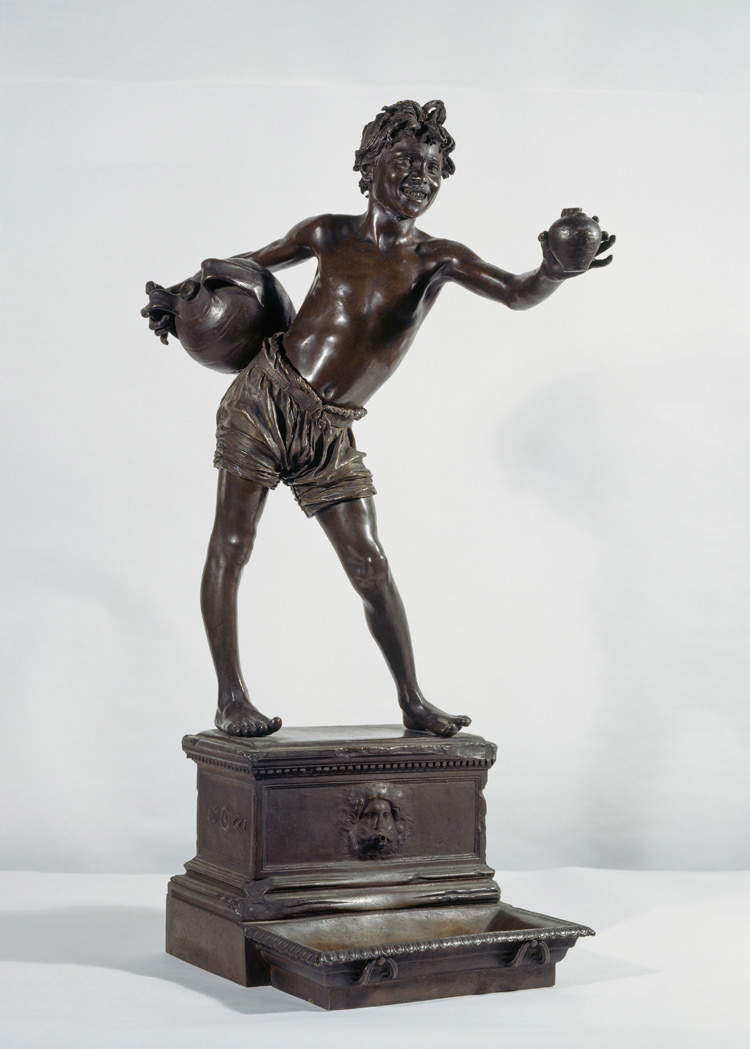 |
| Vincenzo Gemito, The Waterman (1881; bronze, 55 x 19 x 26 cm; Milan, Museo Nazionale Scienza e Tecnologia Leonardo da Vinci) |
 |
| Carlo Fontana, The Waterman (1896; bronze, 49 x 23 x 23 cm; Sarzana, Fontana Family Collection) |
To find more works with a strong social charge, it is necessary to leave Palazzo Cucchiari and investigate other works of the period. A strong stance against the alienation caused by work in industrial society, and also against the damage that child labor was capable of doing to children, from whom their childhood was violently taken away (and often their lives ruined: the grueling shifts in the factory undermined their psychophysical development, and many died of occupational diseases), is what Plinio Nomellini (Livorno, 1866 - Florence, 1943) takes on in one of his most famous masterpieces, as well as the most important painting of the most exquisitely political and committed phase of his career: the 1893 Diana of Work, which captures, at the dawn of a hard day’s work, the workers before the gates of their factory open. In this painting, we read in an essay signed by Mattia Patti, Ezio Buzzegoli, Raffaella Fontana and Marco Raffaelli, “Nomellini gives evidence of a strong modernity of gaze, recounting the call to work of a large and heterogeneous group of workers, who in disorderly rows, almost huddled together, set out in the early morning toward the entrance of a construction site. We are struck in particular by the figures in the foreground: a man staring straight ahead, and a child with a visibly worried look. Nomellini, here, points the finger, ”without rhetoric and with a firm voice,“ at the ”participation of minors and the elderly in the productive system: to the figure of the child, in fact, almost appears the hunched-over old man, with beard, white hair and a spade in his hand, who proceeds slowly, entering the scene from the right edge of the canvas."
Nomellini’s lost gaze of the child is the one we also find in portraits of small female workers such as the tender Venditrice di frutta by Emilio Longoni (Barlassina, 1859 - Milan, 1932) or the Frutera by Giovanni Sottocornola (Milan, 1855 - 1917), two works that are nevertheless as different in their conception as in their technical-stylistic rendering: Sottocornola’s is not touched by the desire to stigmatize child labor, but simply intends to propose a verist portrait of a young fruit seller, tired and tried by the many hours she has spent proposing her wares to buyers, dealing moreover with one of Sottocornola’s favorite subjects (who, however, in his more mature works, would also come to deal more explicitly with the conditions of workers). Longoni’s is a work that “concedes nothing to the anecdotal ’pretty’ that flourished at the time around child labor” (Giovanna Ginex): with a dense and textured brushstroke, far from Sottocornola’s, Longoni empathizes with the poor, sweet little girl, who will be no more than five or six years old, but is forced to do heavy and wearing work.
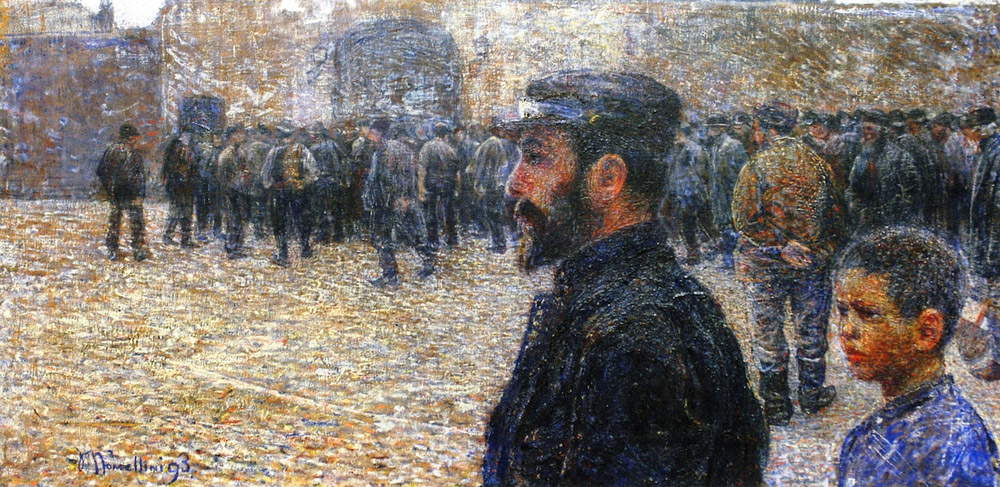 |
| Plinio Nomellini, La diana del lavoro (1893; oil on canvas, 60 x 120 cm; Private collection) |
 |
| Giovanni Sottocornola, La frutera (1884-1886; oil on canvas, 78.5 x 48.5 cm; Milan, Gallerie d’Italia, Piazza Scala) |
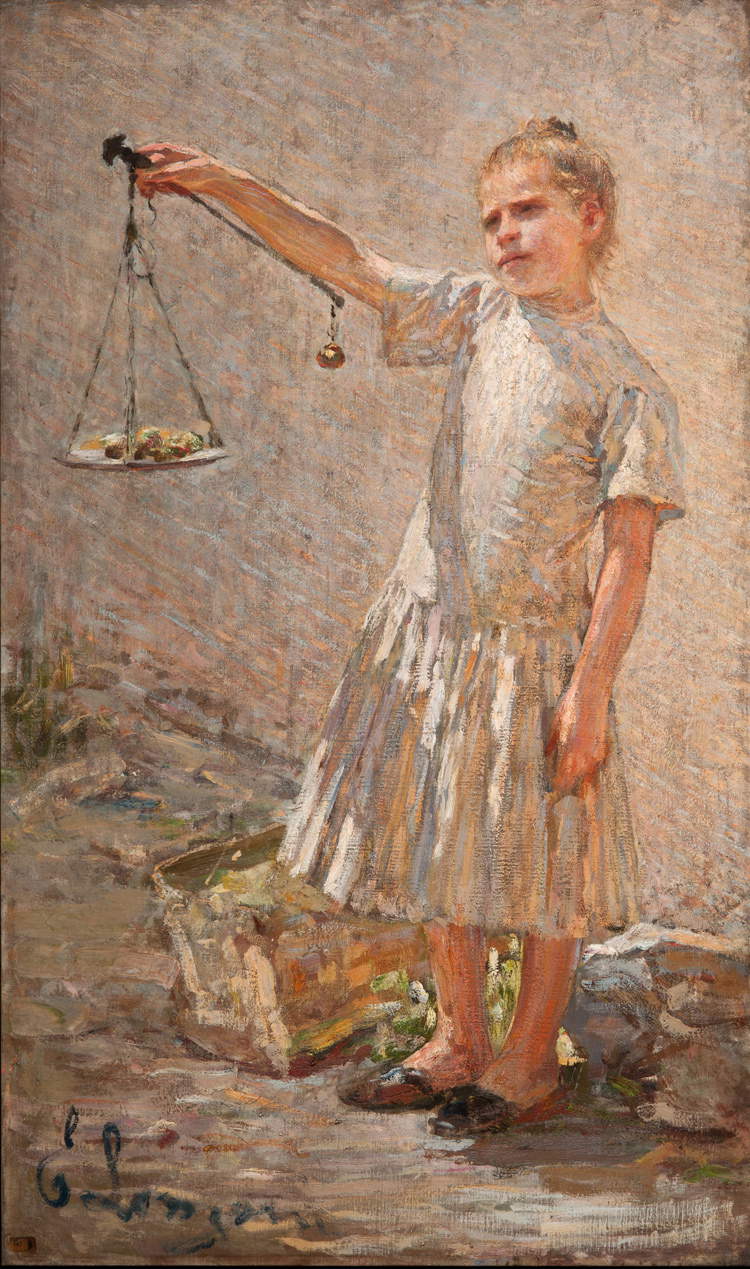 |
| Emilio Longoni, Ona staderada or The Fruit Seller (1891; oil on canvas, 154 x 91 cm; Tortona, Fondazione Cassa di Risparmio di Tortona - Pinacoteca “Il Divisionismo”) |
Little girls at work are also those depicted by Niccolò Cannicci (Florence, 1846 - 1906): one is the Spinner in the exhibition at Palazzo Cucchiari, a portrait of a little girl proceeding outdoors, turning her gaze to the viewer, and holding her spindle in her hand, and others are those we can find among the Gramignaie al fiume, or women who, on the banks of rivers, harvested wheatgrass, a grass considered a weed for agriculture, but excellent for producing hay for horses. This was very hard work, similar to that of the mondine who plied their trade on the rice plantations of northern Italy, and as Cannicci’s painting testifies, could also employ girls.
Another very hard trade, also carried out by large numbers of children, was that of miners in the sulfur mines in Sicily, admirably described by Sidney Sonnino in the second volume of his 1876 Sicily Inquiry: “even in sulphur mines where the extraction of the ore up to the mouth of the mine is done in whole or in part by mechanical means, the work of children is used for the transport of the sulphur from the galleries of excavation up to the point where the vertical shaft or the horizontal gallery corresponds; as well as above ground for the transport of the ore from the place where it remains piled up in boxes, up to the calcarone, that is, the furnace where it is melted. In a great many galleries, however, of these same large mines, and generally in all the other zolfare of Sicily, the work of children consists in transporting on their backs, the ore in sacks or baskets, from the gallery where it is dug by the pickaxe-maker, to the place where in the open air the basterella of the crates of the different pickers is made, before filling the calcarone.” The tragedy of the so-called carusi (“children,” a term typical of eastern Sicily) found a vivid image with Sicilian painter Onofrio Tomaselli (Bagheria, 1866 - 1956), who dedicated what is perhaps his most famous work to the theme of child exploitation in Sicilian mines, I carusi, which depicts some children bent under the weight of sulfur sacks as they leave the mine and walk away under the scorching southern sun, with one of them, exhausted, resting in the shade on the arid ground.
Little miners in the south, little workers in the north: there are not many works that denounce the reality of children employed in the industries of the cities of northern Italy, but it is possible to identify an interesting depiction of the problem in Operai in riposo by Filippo Carcano of Milan (Milan, 1840 - 1914), where the workers resting are actually nothing more than four children: the choice to focus on such small workers is in all likelihood dictated by the desire to express a harsh criticism against child labor.
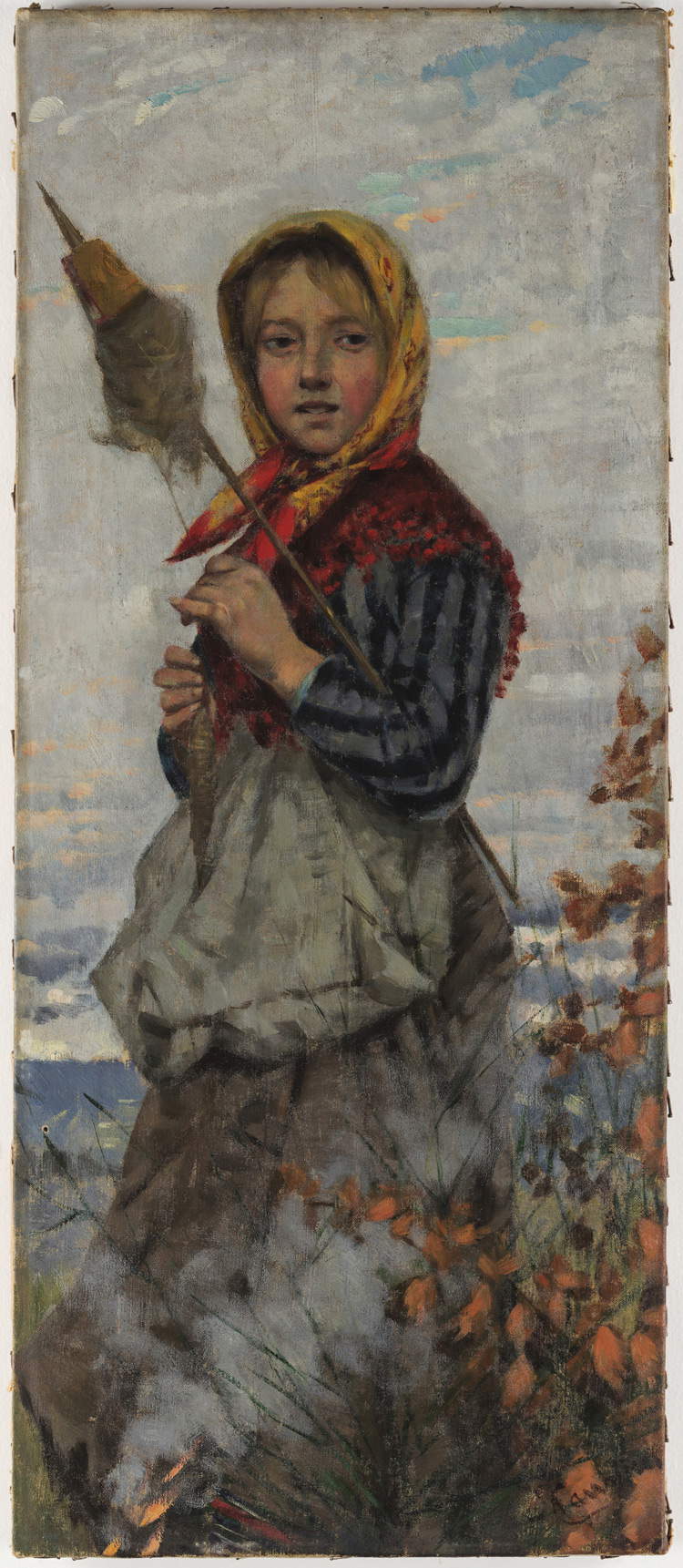 |
| Niccolò Cannicci, The Spinner (1885-1890; oil on cardboard, 57 x 24 cm; Milan, Museo Nazionale Scienza e Tecnologia Leonardo da Vinci) |
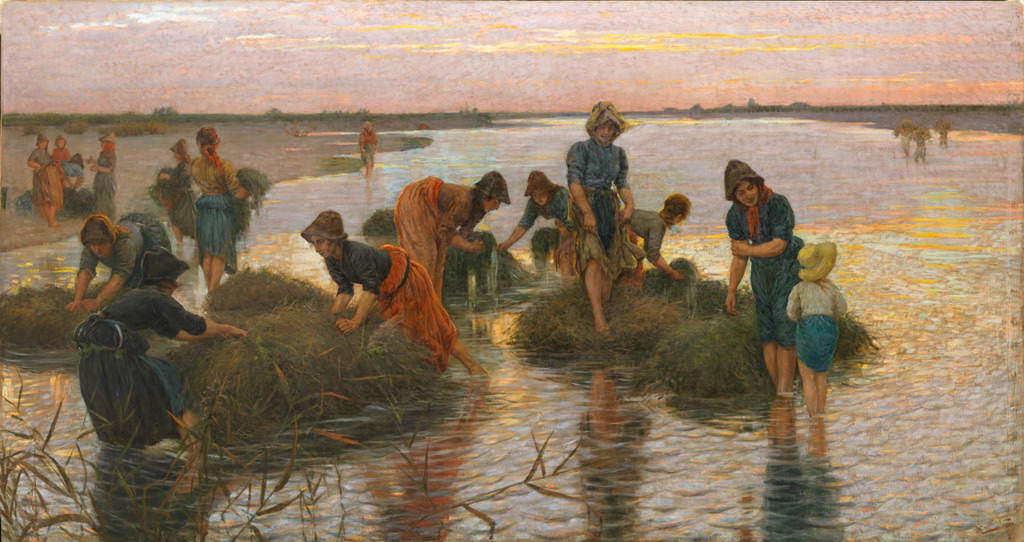 |
| Niccolò Cannicci, Le gramignaie al fiume (1896; oil on canvas, 151 x 280 cm; Florence, Ente Cassa di Risparmio di Firenze Collection) |
 |
| Onofrio Tomaselli, I carusi (c. 1905; oil on canvas, 184 x 333.5 cm; Palermo, Galleria d’Arte Moderna) |
 |
| Filippo Carcano, Workers at Rest (1886; oil on canvas; Private collection) |
Children continued to work early for a long time. Demonstrations of sensitivity to the issue were not many, but they were intense, and they wanted to urge administrations to take action. One reads, for example, in a text of the Savigliano Workers’ Mutual Aid and Education Society, drafted in 1880: “indeed it contrived the soul to see so many and so many poor children by the avarice and ignorance of many parents and by the greed of the industrialists of the various factories, condemned to do the most strenuous work for many hours of the day without any interruption. Poor things! In a few years they then come out exhausted, mangled and exhausted, many of them paying their debt to death before long. For the welfare of the children, and for the increase and prosperity of the arts and industries this society makes warm vows that the new law will as soon as possible have its sanction and be placed in vifore, and seizing in the meantime the propitious occasion, this society allows itself to make it known that it would also be its fervent wish that by the providential Government the daily hours of the children be regulated and fixed not only, but also those of the adults, and that it would extend its supervision and to that end inflict a gradual fine or severe punishment on those parents who subject their children to the harshest treatment for a trifle, on store masters or heads of workshops and their servants who beat their little apprentices or use impudent and immoral language in their presence, the latter of whom, having later become adults, will, with very few exceptions, be villains in their turn.”
Policy responses, however, were haphazard and came late. One of the earliest laws dated back to 1866, but it merely set nine years as the minimum limit for working (it was raised to ten for work in quarries and mines and fifteen for hazardous work). The law, number 3657, was not very effective, however, partly because there were no definite numbers on the amount of infants employed in work settings: inquiries were therefore initiated, and thanks to their fruits in 1876 measures were taken to reduce working hours, but the raising of the minimum age to twelve (and to thirteen for quarries and mines), came only in 1902, with law number 242, which also established a maximum of eight working hours for children up to twelve and eleven for boys up to fifteen. In 1904, policymakers sensed that a powerful weapon against child labor was schooling: thus, compulsory schooling was raised from age nine to twelve, and the law establishing it was reinforced a few years later with the passage of a measure mandating a three-year elementary school graduation requirement for access to employment. It was not until 1919 that the International Labor Organization adopted the Convention on Minimum Age in Industry, establishing that the minimum age of consent to work in factories was fourteen, and it was as late as 1967 that the Italian law (number 977) raised the minimum age for work to fifteen.
Generally, when people think of child labor these days, they imagine it as a distant problem, affecting only developing countries (where, moreover, there are still millions of children forced to work in often inhumane conditions: more specifically, Save the Children estimates that there are 168 million little ones working): in reality, even in the Italy of 2018, child labor is a practice that is far from being eradicated. The Game over survey, also published in 2013 by Save the Children, estimates that today there are about 260,000 children under the age of 16 working in Italy, representing 5.2 percent of the population. 30.9 percent of them are engaged in domestic activities, there is an 18.7 percent who engage in activities in the restaurant sector, 14.7 percent of vendors (including street vendors), and 13.6 percent of children who engage in activities in the countryside. Of course, today’s Italy is not what it was at the end of the 19th century, and that of child labor today is an exceedingly complex phenomenon that varies greatly according to the social and geographical realities involved, but it is also worth pointing out that, according to Save the Children’s research, “in the realities explored, it does not seem that there are any jobs that can be defined as good for children,” and that “most of the young people” who were surveyed “do not see a positive future and have no dreams, they are content, live by the day and have no hope.”
Reference bibliography
Warning: the translation into English of the original Italian article was created using automatic tools. We undertake to review all articles, but we do not guarantee the total absence of inaccuracies in the translation due to the program. You can find the original by clicking on the ITA button. If you find any mistake,please contact us.